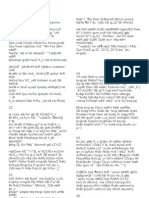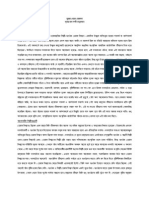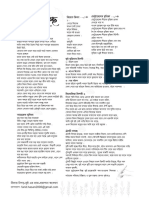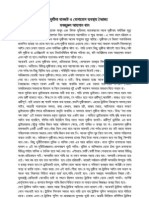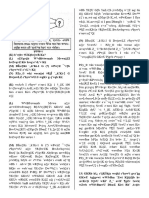0 ratings0% found this document useful (0 votes)
29 viewsCu DVJV Ivmt Av VŠZ GVQ Iæb RVZXQ GVQ, Wks GV I I CV VM Iv Mi J Y
Cu DVJV Ivmt Av VŠZ GVQ Iæb RVZXQ GVQ, Wks GV I I CV VM Iv Mi J Y
Uploaded by
Ahmed RashidThe document summarizes the causes and treatment of waterlogging in crops. It states that:
Waterlogging occurs as water from rainfall gets trapped in the fields and rises up through the soil. This excess water negatively impacts crop growth over time. National Water Management Authority identifies improper irrigation as the main cause.
To treat affected crops, farmers should drain excess water from the fields by digging shallow channels. Alternatively, they can add 200 grams of bleaching powder to each liter of water and pour it on the crops.
Prevention methods include applying ash on bunds every few days, using weed-free irrigation water, providing proper drainage, and ensuring alternative wetland crops are grown in rotation.
Copyright:
© All Rights Reserved
Available Formats
Download as PDF, TXT or read online from Scribd
Cu DVJV Ivmt Av VŠZ GVQ Iæb RVZXQ GVQ, Wks GV I I CV VM Iv Mi J Y
Cu DVJV Ivmt Av VŠZ GVQ Iæb RVZXQ GVQ, Wks GV I I CV VM Iv Mi J Y
Uploaded by
Ahmed Rashid0 ratings0% found this document useful (0 votes)
29 views1 pageThe document summarizes the causes and treatment of waterlogging in crops. It states that:
Waterlogging occurs as water from rainfall gets trapped in the fields and rises up through the soil. This excess water negatively impacts crop growth over time. National Water Management Authority identifies improper irrigation as the main cause.
To treat affected crops, farmers should drain excess water from the fields by digging shallow channels. Alternatively, they can add 200 grams of bleaching powder to each liter of water and pour it on the crops.
Prevention methods include applying ash on bunds every few days, using weed-free irrigation water, providing proper drainage, and ensuring alternative wetland crops are grown in rotation.
Original Description:
in BD
Original Title
Dopsy
Copyright
© © All Rights Reserved
Available Formats
PDF, TXT or read online from Scribd
Share this document
Did you find this document useful?
Is this content inappropriate?
The document summarizes the causes and treatment of waterlogging in crops. It states that:
Waterlogging occurs as water from rainfall gets trapped in the fields and rises up through the soil. This excess water negatively impacts crop growth over time. National Water Management Authority identifies improper irrigation as the main cause.
To treat affected crops, farmers should drain excess water from the fields by digging shallow channels. Alternatively, they can add 200 grams of bleaching powder to each liter of water and pour it on the crops.
Prevention methods include applying ash on bunds every few days, using weed-free irrigation water, providing proper drainage, and ensuring alternative wetland crops are grown in rotation.
Copyright:
© All Rights Reserved
Available Formats
Download as PDF, TXT or read online from Scribd
Download as pdf or txt
0 ratings0% found this document useful (0 votes)
29 views1 pageCu DVJV Ivmt Av VŠZ GVQ Iæb RVZXQ GVQ, Wks GV I I CV VM Iv Mi J Y
Cu DVJV Ivmt Av VŠZ GVQ Iæb RVZXQ GVQ, Wks GV I I CV VM Iv Mi J Y
Uploaded by
Ahmed RashidThe document summarizes the causes and treatment of waterlogging in crops. It states that:
Waterlogging occurs as water from rainfall gets trapped in the fields and rises up through the soil. This excess water negatively impacts crop growth over time. National Water Management Authority identifies improper irrigation as the main cause.
To treat affected crops, farmers should drain excess water from the fields by digging shallow channels. Alternatively, they can add 200 grams of bleaching powder to each liter of water and pour it on the crops.
Prevention methods include applying ash on bunds every few days, using weed-free irrigation water, providing proper drainage, and ensuring alternative wetland crops are grown in rotation.
Copyright:
© All Rights Reserved
Available Formats
Download as PDF, TXT or read online from Scribd
Download as pdf or txt
You are on page 1of 1
cU dvjv ivMt
AvvZ gvQ iB RvZxq gvQ, wks gvi I cvvm
ivMi jY
gvQi `ni is dvKvk nq hvq Ges cvwb mvjbi gvag cU dzj hvq
gvQ fvimvgnxbfve PjvPj Ki Ges cvwbi Ici fm _vK| AwPiB AvvZ
gvQi gZz NU
Gvivbvgvm RvZxq evKUwiqv G ivMi KviY
wPwKrmv
Avv gvQK
Lvwj wmwi w`q gvQi cUi cvwb ei Ki wbZ ne| cwZ KwR gvQi Rb 25
wgtMvt nvi KvivgdwbKj BbRKkb w`Z ne| A_ev,
cwZ KwR Lvevii mv_ 200 wgt Mvt KvivgdwbKj cvDWvi wgwkq Lv` Zwi
Ki gvQK LvIqvbv hZ cvi |
cwZiva
cwZ kZvsk Rjvkq 1 KwR nvi Pzb cqvM Kib
gvQi Lvevii mv_ wdkwgj eenvi Kib
gvQK mylg Lv` mieivn Kieb
cvKwZK Lvevi wnme cvsKUbi ^vfvweK Drcv`b wbwZ Kib |
You might also like
- Technique KGBDocument8 pagesTechnique KGBShamsNo ratings yet
- MVWF Qu Ivwkqvi K WR Weõi Mí: KVFB KVGMDocument15 pagesMVWF Qu Ivwkqvi K WR Weõi Mí: KVFB KVGMShamsNo ratings yet
- Unit 02 PDFDocument30 pagesUnit 02 PDFrussellNo ratings yet
- Masud RanaDocument38 pagesMasud RanaJantrik Shopno50% (2)
- Bondi-Jibon-27.-2022-x9fec1Document62 pagesBondi-Jibon-27.-2022-x9fec1Print Media (Helicopter)No ratings yet
- Kathpakathan 21-40Document4 pagesKathpakathan 21-40Parvez AhamedNo ratings yet
- BD Gazat 50Document10 pagesBD Gazat 50SofiqNo ratings yet
- Ex. Syed Abul Hossain InnocenceDocument13 pagesEx. Syed Abul Hossain InnocenceLokman1991No ratings yet
- Kather Shorir BookDocument32 pagesKather Shorir BookbdmagicNo ratings yet
- 28 12 2024_Ek Chimty Hashi Final BookDocument56 pages28 12 2024_Ek Chimty Hashi Final BookSumon SiddikiNo ratings yet
- Kalo Noksh - Masud RanaDocument110 pagesKalo Noksh - Masud Ranakazi_shafiqul19860% (1)
- H Av B Qwo Q MJ Melv B - Arq Ivq: 'Yb©XwzDocument3 pagesH Av B Qwo Q MJ Melv B - Arq Ivq: 'Yb©Xwzvladimirkulf2142No ratings yet
- Uv BJ Mshy Ki E Ivwkqv I Av Gwikv KDocument8 pagesUv BJ Mshy Ki E Ivwkqv I Av Gwikv Kshore_aabasonNo ratings yet
- Mission Tel Aviv PDFDocument84 pagesMission Tel Aviv PDFgreedyloanerNo ratings yet
- Bangla BijoyDocument77 pagesBangla BijoyDipon ChandaNo ratings yet
- বিজ্ঞান ও প্রযুক্তিDocument21 pagesবিজ্ঞান ও প্রযুক্তিpowrovumiofficeNo ratings yet
- Hemanga Biswas-Surma Theke VolgaDocument10 pagesHemanga Biswas-Surma Theke VolgaSubha Prasad Nandi MajumdarNo ratings yet
- Avh© MGVR I MF ZV: Evsjv 'K DB Y Wek We' VJQDocument30 pagesAvh© MGVR I MF ZV: Evsjv 'K DB Y Wek We' VJQScientia Online CareNo ratings yet
- Case Study 2Document4 pagesCase Study 2mhossainju007No ratings yet
- Unit 03Document29 pagesUnit 03Handsom BoyNo ratings yet
- Boston JolccheDocument75 pagesBoston JolccheKazi Shafiqul AzamNo ratings yet
- How The Khilafah Will Industrialize in The Muslim WorldDocument8 pagesHow The Khilafah Will Industrialize in The Muslim Worlderror.sutNo ratings yet
- Communalism in Bangladesh: Problems and Way of SolvingDocument173 pagesCommunalism in Bangladesh: Problems and Way of SolvingCLEANNo ratings yet
- Unit 07Document22 pagesUnit 07PARVEZNo ratings yet
- Shashwatiki - Onubad PDFDocument96 pagesShashwatiki - Onubad PDFTarique MahamudNo ratings yet
- Lecture 5Document11 pagesLecture 5Zia OulNo ratings yet
- Trial SystemDocument25 pagesTrial Systemarthy.azmeduNo ratings yet
- Chander HashiDocument48 pagesChander Hashiনাসির আহমেদ কাবুলNo ratings yet
- Betar - Bangladeshe Motsho Shikkhar GuruttoDocument3 pagesBetar - Bangladeshe Motsho Shikkhar GuruttoAhmed RashidNo ratings yet
- CTPAT SecurityDocument48 pagesCTPAT SecurityKhorshed AlamNo ratings yet
- Unit 03Document14 pagesUnit 03shuvra01206No ratings yet
- DCGNV ' K BD Ivcxq 'I Avmgb I Bs Ir KVM Bi M PBV: BdwbuDocument22 pagesDCGNV ' K BD Ivcxq 'I Avmgb I Bs Ir KVM Bi M PBV: BdwbuScientia Online CareNo ratings yet
- ChhayamurtiDocument6 pagesChhayamurtiapi-3803371100% (1)
- BCS Written L-07-1Document13 pagesBCS Written L-07-1Mehedi FaysalNo ratings yet
- 2. Fire FightingDocument64 pages2. Fire FightingBaharNo ratings yet
- Kobita FinalDocument1 pageKobita FinalskmahidulhassanmustakNo ratings yet
- কম্পিউটার১ শর্ট সাজেশনDocument18 pagesকম্পিউটার১ শর্ট সাজেশনpowrovumiofficeNo ratings yet
- Presentation 082143Document11 pagesPresentation 082143Mahmudul HasanNo ratings yet
- Lex-1 3Document2 pagesLex-1 3rayhanr2324No ratings yet
- Data Communication System (Chapter 1)Document4 pagesData Communication System (Chapter 1)anisur1947sNo ratings yet
- Manzur Transport ProtidinDocument4 pagesManzur Transport ProtidinmanzurcpbNo ratings yet
- GMGMGBPGJ: Gyw Hy× I Ewnwe©KDocument39 pagesGMGMGBPGJ: Gyw Hy× I Ewnwe©KScientia Online CareNo ratings yet
- Unit 02Document18 pagesUnit 02ankurbasak935No ratings yet
- Tagor Issue, ShashwatikiDocument88 pagesTagor Issue, ShashwatikiKulodaRoyNo ratings yet
- Cövpxb Fvi Zi MVG VR : Evsjv 'K DB Y Wek We' VJQDocument61 pagesCövpxb Fvi Zi MVG VR : Evsjv 'K DB Y Wek We' VJQScientia Online CareNo ratings yet
- Al Mahmood, Sonali KabinDocument13 pagesAl Mahmood, Sonali KabinMohammad Azam100% (1)
- Computer JagatDocument59 pagesComputer JagatMd.Tariq RusselNo ratings yet
- VMZGDocument11 pagesVMZGTB AhmedNo ratings yet
- Return Form Fill Up Guidline 040911Document109 pagesReturn Form Fill Up Guidline 040911Ashraf AtiqueNo ratings yet
- Weá Avgjx Av'Vjz Ewikvj, EwikvjDocument3 pagesWeá Avgjx Av'Vjz Ewikvj, Ewikvjsigncomputer718No ratings yet
- Gyn ' Rvdi Bkevj: Evsjv MNVQK MVWNZDocument14 pagesGyn ' Rvdi Bkevj: Evsjv MNVQK MVWNZdudumiam3No ratings yet
- Fashion Lead 20-04-2019Document7 pagesFashion Lead 20-04-2019gentlepark ecomarceNo ratings yet
- DEBDASDocument62 pagesDEBDASxyzkrish041No ratings yet
- Cash Study Umme SadiaDocument16 pagesCash Study Umme Sadianokia131bdNo ratings yet
- Wzpviy: Q J Ejvi Cy RV: - Aa VCK MBWRZ Kzgvi 'EDocument4 pagesWzpviy: Q J Ejvi Cy RV: - Aa VCK MBWRZ Kzgvi 'EAnonymous 61tpGcRVqONo ratings yet
- Chapter 1Document10 pagesChapter 1sksjakariaNo ratings yet
- Autism Spectrum BookDocument23 pagesAutism Spectrum BookDr. Abir DuttaNo ratings yet
- September 2017Document40 pagesSeptember 2017knowledgehunterbbNo ratings yet
- Bachchon Ki Manoranjak Kahaniyan: Shikshaprad Kahavton Par AadharitFrom EverandBachchon Ki Manoranjak Kahaniyan: Shikshaprad Kahavton Par AadharitNo ratings yet
- Unit of InterestDocument1 pageUnit of InterestAhmed RashidNo ratings yet
- AnswerDocument3 pagesAnswerAhmed RashidNo ratings yet
- Collection of SisDocument4 pagesCollection of SisAhmed RashidNo ratings yet
- Leach DiseaseDocument1 pageLeach DiseaseAhmed RashidNo ratings yet
- Z Ivm Gi J Y, Kviy I M Ve Cöwz Lab/Cöwzkv Ii Civgk©CîDocument1 pageZ Ivm Gi J Y, Kviy I M Ve Cöwz Lab/Cöwzkv Ii Civgk©CîAhmed RashidNo ratings yet
- Trarsportation of Fongerling & Stocking - 0Document5 pagesTrarsportation of Fongerling & Stocking - 0Ahmed RashidNo ratings yet
- Lvupvq GV Qi Gry' NBZ¡ Wba©Viy: 1. Cvwbi M VZ TDocument5 pagesLvupvq GV Qi Gry' NBZ¡ Wba©Viy: 1. Cvwbi M VZ TAhmed RashidNo ratings yet
- Sanctuary of SisDocument5 pagesSanctuary of SisAhmed RashidNo ratings yet
- Fish Health ManagementDocument4 pagesFish Health ManagementAhmed RashidNo ratings yet
- Luvpvq GVQ PV Li Avw - ©K We Kly: 1 - Luvpv 'VC Bi 'VQX Lip (Uvkv) T Dckiy Cwigvb GKK G J (Uvkv) Gvu G J (Uvkv)Document3 pagesLuvpvq GVQ PV Li Avw - ©K We Kly: 1 - Luvpv 'VC Bi 'VQX Lip (Uvkv) T Dckiy Cwigvb GKK G J (Uvkv) Gvu G J (Uvkv)Ahmed RashidNo ratings yet
- Cage Culture Inspection & ReportDocument1 pageCage Culture Inspection & ReportAhmed RashidNo ratings yet
- Cage Preparation & PlacingDocument6 pagesCage Preparation & PlacingAhmed RashidNo ratings yet
- Water, Disease & Risk ManagementDocument2 pagesWater, Disease & Risk ManagementAhmed RashidNo ratings yet
- Luvpvq GVQ PV Li Cuf WGDocument6 pagesLuvpvq GVQ PV Li Cuf WGAhmed RashidNo ratings yet
- GVQ PV L Gvwui Yv Y: Gvwui DCV'VB I Gi Cökvi F' Gvwui DCV'VBDocument8 pagesGVQ PV L Gvwui Yv Y: Gvwui DCV'VB I Gi Cökvi F' Gvwui DCV'VBAhmed RashidNo ratings yet
- Scope & ImportanceDocument4 pagesScope & ImportanceAhmed RashidNo ratings yet
- Importance of Natural FoodDocument6 pagesImportance of Natural FoodAhmed RashidNo ratings yet
- 1.BFRI Technologies ListDocument2 pages1.BFRI Technologies ListAhmed RashidNo ratings yet
- Life Cycle of PrawnDocument7 pagesLife Cycle of PrawnAhmed Rashid100% (1)





